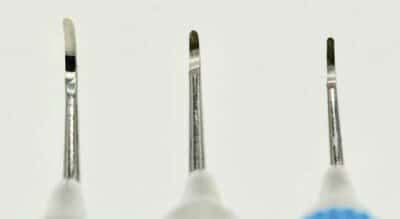 RistoArnaudov / iStock / Getty Images Plus
RistoArnaudov / iStock / Getty Images Plus
Making the Right Choice
Appropriate instrument selection is integral to successful nonsurgical periodontal therapy.
Securing access and removing all calculus deposits are key to successful nonsurgical periodontal therapy outcomes. And instrument selection is integral to accessing difficult root morphology and reaching the base of the pocket. Assessing the tissue tone, clinical attachment loss, root morphology, and accessibility determines which instruments are suitable to accomplish complete root debridement.
Terminal shank length and instrument blade thickness should be considered in order to access the pocket and tissue. The use of standard thick- and large-bladed instruments can cause trauma to the soft tissue when forced into the pocket. If the blade is too thick or too long to safely insert subgingivally, accessing the base of a pocket becomes impossible.
Mini-bladed Gracey curets and micro-mini-bladed Gracey curets are good alternatives to the standard Gracey instrument. Their thinner blades provide access to the pocket and ensure debridement for this type of tissue without trauma. A microscopic analysis study showed that mini-bladed, area-specific curets were optimal for root instrumentation in terms of both calculus removal and surface alterations when compared to standard area-specific and power instruments.1

micro-mini-bladed Gracey curets. © Michaela Nguyen, RDH, BSDH, MS
INSTURMENT CHARACTERISTICS
Both mini- and micro-mini-bladed Gracey curet designs have a terminal shank 3 mm longer than the standard Gracey curet for deep access into pockets. In addition, the blade on the mini-bladed Gracey curet is 50% smaller in length and width than that of a standard Gracey.
The micro-mini-bladed curets are 20% smaller than the mini-bladed Gracey curet, therefore, 70% smaller in length and width than a standard Gracey curet blade (Figure 1). The shorter, thinner blades and extended shanks enable them to reach deeper and improve access in periodontal pockets than any other hand instruments, while also reducing tissue distension and easing subgingival insertion.
Mini- and micro-mini-bladed Gracey curets were developed to adapt well to contours of the tooth including the cementoenamel junctions, line angles, root depressions, concavities, furcations, and narrow pocketing.2 In the past, the only solution to access these difficult areas was to use the Gracey curet with a toe-down horizontal stroke.
Mini- and micro-mini-bladed Gracey curet instruments now allow access to areas that previously were extremely challenging to reach with complete root coverage using multidirectional strokes.
REFERENCES
- Profili F, Sparabombe S, Smith AT, D’Isidoro O, Quaranta A. The effect of miniaturized manual versus mechanical instruments on calculus removal and root surface characteristics: an in vitro light microscopic study. Clin Exp Dent Res. 2019;5:519–527.
- Newman M, Takei H, Klokkevold P, Carranza F. Newman and Carranza’s Clinical Periodontology. 13th ed. St. Louis: Elsevier/Saunders; 2019.
This information originally appeared in Sanchez JS, Nguyen M. Improve nonsurgical periodontal therapy with appropriate instrument choice. Dimensions of Dental Hygiene. 2021;19(2):16–21.


